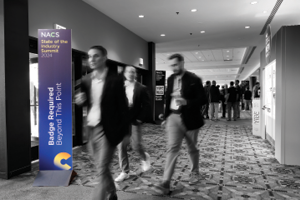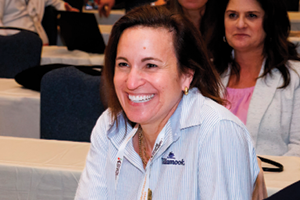We’ve all heard that the pace of change is accelerating faster than it ever has. That’s true—and will likely always be true.
Today, a business makeover life cycle can be as short as four to seven years, compared to the past where businesses could go decades without having to significantly reinvent themselves.
The NACS State of the Industry Summit presented a compelling case for why—and how—retailers can change. It was a chance for 600-plus attendees to move on signals, instead of following what others are already doing.
 Attendees heard how the industry is in back-to-basics mode ... and accelerating towards the future.
Attendees heard how the industry is in back-to-basics mode ... and accelerating towards the future.Keynote speaker Crystal Washington said that a period of rapid change—such as the one we are now experiencing—should be thought of as a “renaissance,” a period during which great things are possible. “How do you innovate out of customer utility instead of out of fear of being left behind?” she asked attendees.
That was the whole point of the two-day Summit. It presented reams of data and analysis, all designed to share ideas for how NACS members can best marshal their resources, define how they can look at change and ultimately grow their businesses.
The future “will require you to both think slow and think fast” in how you approach long-term strategies and attack short-term issues, noted NACS Chairman and CEO Henry Armour.
Six common themes emerged from the presentations.
Foodservice Is the Difference
The c-store industry has experienced over two decades of record in-store sales, and foodservice has played a central role in that. Foodservice now accounts for 30% of in-store revenues and 37% of profit dollars. A stunning one in four gas customers (25%) who went inside the store when buying gas say they purchased a sandwich or meal on that trip (May 2024 NACS Magazine, “A Parting of the Clouds”).
The growth of foodservice has been so profound that the overall industry model has shifted to one where drivers no longer think of c-stores as a place to buy fuel and maybe also get food. Instead, they are restaurants that also happen to sell fuel.
That doesn’t mean that everyone does foodservice well. The difference between the top 10% of the industry and bottom 10% is stark, with the top performers selling 5.5 times more foodservice, resulting in profits that were 12.5 times higher.
How do you innovate out of customer utility instead of out of fear?”
And it also doesn’t mean that foodservice is easy. Wages and benefits for top performers are more than double those of the bottom performers, and the costs of spoilage can be high.
Also, just because the industry has specific category definitions doesn’t mean that customers think that way. Portability and low price points also provide some non-traditional opportunities for snacks that become meals, whether string cheese, yogurt, a piece of fruit or other snacks merchandised in the open-air cooler or in other areas. Those offers greatly reduce labor costs and spoilage associated with traditional foodservice. And they may appeal more to customers on weight-loss drugs like Ozempic that can tamp down the desire for a larger meal. These customers are eating differently, but not less, noted David Portalatin, senior vice president and industry advisor for food and foodservice at Circana.
Retailers offering traditional foodservice are winning sales increases by focusing on special offers exclusively for food, as opposed to a food and beverage tie in. After all, most customers purchasing food are naturally going to purchase a beverage. “Strategically, you have to focus on an approach where foodservice is an integral part of your future,” said Armour.
Overall U.S. foodservice sales are expected to grow 1% in 2024—meaning 580 million more visits to restaurants and retail outlets selling food. “Get your share,” said Portalatin.
Everyone Is Competition—and Coming for Your Business
C-stores aren’t the only channel innovating. So are grocers and QSRs, and in most cases they are looking to grow their share of the convenience market.
Aldi launched a “virtual c-store” that provides 30-minute delivery for 2,000 items. Dollar General has 5,000 stores that offer fresh produce. Chick-fil-A is opening pickup-only lanes at select stores.
Changes in commuting patterns are also reshaping the competitive landscape. Work-from-home policies for office workers have taken a big bite out of lunch sales, with many workers opting to make their lunch at home once or twice a week instead of going out with colleagues. Lunch sales may never come back to pre-pandemic levels, and that loss of core business for QSRs means that they are looking at traditional c-store dayparts to grow sales—especially breakfast, afternoon snack time and late night/early morning.
QSRs are aggressively rolling out morning sweets and other snacks that extend their offer to target these dayparts (for example, KFC brownies) that have traditionally been dominated by c-stores.
“QSRs are coming for your business,” said Portalatin.
It’s the Consumer, Stupid
Former President Clinton’s campaign manager James Carville coined the memorable phrase “It’s the economy, stupid,” and ever since it’s been a way to remind politicians to pay attention to the top issue that affects consumers.
But today, economic sentiment is complicated. It’s not stupid to ask what “the economy” even means to consumers.
On a macroeconomic level, the economy looks pretty good: The first quarter of 2024 saw double-digit stock market returns. Housing values have soared over the past few years, enriching those in certain markets. Other economic indicators—unemployment and inflation, in particular—point toward a “Goldilocks economy” that is not too weak or too strong, noted John Benson, a partner at AlixPartners.
Merchandise shrink almost doubled to $2.5 billion
However, on a microeconomic level where consumers are, things are tougher. Inflation has cooled, but it’s still over 3%, and key categories of inflation are growing faster than wages, such as housing, which hovers just under 6%. That continues a worrisome trend of costs outpacing wages. Overall, there has been a 4.7% decrease in real median income since 2019.
Also, consumer debt has increased, especially credit card debt, which jumped 14.1% from 2022 to 2023. Consumer spending is further limited by the more than 20 million people who had student loan payments restart in October after a long pandemic-related pause.
These pocketbook concerns could all cut into spending, and that’s a big concern; 40% of business leaders say that inflation and high interest rates are a significant threat to their business.
This price sensitivity is also playing out with foodservice: 90% of restaurants say that customers are value conscious. Families with children are the most likely to abandon eating out because of costs.
Even those who aren’t eating out less are eating out differently. QSR customers are trading down purchases, opting for smaller drink or meal sizes and selecting regular sandwiches instead of the premium offers they previously purchased. And, while families with kids are eating out less, kid’s meals have grown in popularity. Adults are increasingly purchasing these meals for themselves to limit costs and for portion control. There could be an opportunity to rebrand these meals to reflect the expanding sales opportunities.
Price sensitivity is also on c-store customers’ minds: 56% of them say they favor a specific c-store because it usually has lower prices (May 2024 NACS Magazine, “A Parting of the Clouds”) and the value-priced 4th tier cigarette subcategory showed a substantial sales increase even as cigarette sales overall continue their long-term decline.
Get Ruthless on Efficiencies
With competition intensifying and consumers seeking out value, aggressively managing costs is essential.
Be ruthless when pruning menu items, speakers suggested. A too-broad menu increases costs across the board, especially from spoilage. Foodservice waste grew 17.6% in 2023, which is down from the 33.2% in 2022, but the cumulative two-year effect puts huge pressure on margins. Reduce menu items that add to spoilage, take too much time to prepare or require added storage or training.
Overall, direct store operating expenses (DSOE) continue to go up. Despite an overall decrease in gas prices in 2023, card fees grew to $19.7 billion. (Go to the “advocacy” tab on convenience.org to send an e-mail to your elected leaders to support the Credit Card Competition Act.)

Crime also has an impact on costs: Merchandise shrink almost doubled in 2023 to $2.5 billion.
Softer sales in the first few months of the year make it even more essential to aggressively manage costs.
“The path to profitability requires tighter expenses control with sales and profits down from November 2023 to February 2024,” said Varish Goyal, president and CEO of Loop Neighborhood Markets.
AI Is Not a Joke
We’ve all seen the bad side of artificial intelligence (AI), whether photos with six-fingered people or sentences that are more confounding than assembly instructions for IKEA furniture.
However, whether you like it or not, AI will have a dramatic impact on our industry.
“AI has been described as something that comes slowly, then suddenly. Well, we’re in ‘suddenly,’” said Armour.
AI is much more than just ChatGPT. It can significantly help drive efficiencies.
For example, Circle K is deploying more than 10,000 AI-camera checkout systems to make transactions quicker.
The NACS SOI Summit heads to Dallas next year. It will be held April 8-10 at the Hyatt Regency at DFW International Airport, the same location as the 2023 event.
AI can help with loss prevention—it can, for example, flag if a pack of cigarettes leaves the backbar but there’s no corresponding purchase. It can cut the phone line based on key-word detection when a gift card scam is called in to an employee.
The technology can even help track how employees interact with customers, allowing stores to refine messaging and reward good behavior.
“AI helps you get out of clutter,” said Robert Hampton, vice president of technology and services at Jacksons Food Stores, “and allows you to focus on how to remove friction for the customer.”
AI also can help with fuel-pricing decisions—but it’s still too early to automate decisions that require the nuance that humans still provide better. It is more valuable for arbitrage for companies buying fuel, especially for their fleets.
While AI can help with efficiencies, it does raise larger concerns about the electric grid. AI computing pulls an increasingly high share of the nation’s electricity. More AI will require massive upgrades to the system and perhaps inhibit the growth of EVs. On the flip side, as AI becomes more powerful and people become more comfortable deferring to machine wisdom, autonomous driving may become more routine.
Let’s Get Phygital
Ninety percent of Americans have cell phones and they spend a lot of time on them—an average of 4.5 hours per day. Washington said that if you take your phone to bed—or your bedside—you’re probably addicted to it. “If you did the same thing with a beer every night, we’d be talking about that being a problem,” she joked.
As screen time pushes further into daily life, retailers can look at opportunities to meld both the physical and digital worlds into a phygital world that maximizes customer engagement.
Get consumers to use your mobile app and then use the app to tell the story about how much you give back to the community, noted Sanjeev Satturu, senior vice president and chief information officer at Casey’s.
And as the IT team builds out technology, make sure that they understand the end user’s needs. Require them to be in stores once a week, said Satturu.
Most of all, customize offers for customers in the digital world.
“If you just throw stuff at them, you become spam,” said Conexxus Executive Director Gray Taylor. “It’s about personalization and community.”
The digital world also presents challenges for convenience retailers, especially with foodservice. Data from Circana shows that 27% of c-store lunch customers are there because it’s a convenient location, while only 10% select the store because “I like it there.” If the competition makes their food more convenient in the digital realm, you’ll have to win on taste and value.
Autonomous vehicles, another technology that will come slowly, then suddenly, also could decrease impulse sales and make it more important to offer foodservice that drivers seek out.
What’s Next?
There is no one-size-fits-all answer for retailers. Those who focus on leveraging their strengths to give customers what they want—or don’t yet know that they want—are the ones most likely to be high performers.
It’s a matter of reviewing broad trends and those specific to your business. After all, your frontline people who interact with customers every day already have key insights to redefine your future. And so does NACS, both with its suite of State of the Industry products and other research.
“Go seize the future,” implored NACS Vice President of Research and Education Lori Buss Stillman in closing the Summit.
A First-Timer’s View
The SOI Summit audience is a mix of retailers looking to improve their business and suppliers looking to refine their knowledge of the industry to better serve their customers. We thought it would be interesting to talk with a first-time attendee to get a better sense of what brought her to SOI Summit and what she found most interesting.
—Chris Rapanick, guest editor
Take us inside your world a little bit. What brought you to the SOI Summit? What stood out to you?
A lot of people I met at SOI know Tillamook from the grocery store, and that is a result of our growth journey, largely over the past five years. During that time, we’ve expanded from being a regional to a national brand, now found in 80% of grocery stores, and in one in four homes. We also continue to be the top cheese brand that is called out on restaurant menus.
We just reached that point in the last six months or so. With that, and the fact that we recently released eight SKUs of our ice cream in pints—a form we know is well-positioned for convenience—I went to the SOI Summit to begin to better understand how shoppers use c-stores differently than the channels we are already in. We know our shoppers are in the convenience channel, and we want to be where they are.
 Alison Rosenblum, business development, Tillamook County Creamery Association
Alison Rosenblum, business development, Tillamook County Creamery AssociationWe’re currently working with distributors as well as several convenience chains to build a plan to enter the channel. Our goal will be to help convenience store operators address challenges I heard discussed at the Summit, and to support as they seek to increase transactions, and compete for larger share of stomach. We don’t expect this to happen overnight. We’ll take a thoughtful, measured approach to testing and learning in this very data-driven channel. One focus area was understanding channel leakage, after one of the presenters said 25% of c-store visitors are going to a QSR within 30 minutes. This raised questions for me about what role we may play in keeping those food purchases in the channel?
My experience at the event was overall positive. I felt very welcomed, and the NACS team helped me find my way as a first-timer. I had done my homework and had researched who I hoped to connect with, and the atmosphere was very conducive to these discussions.